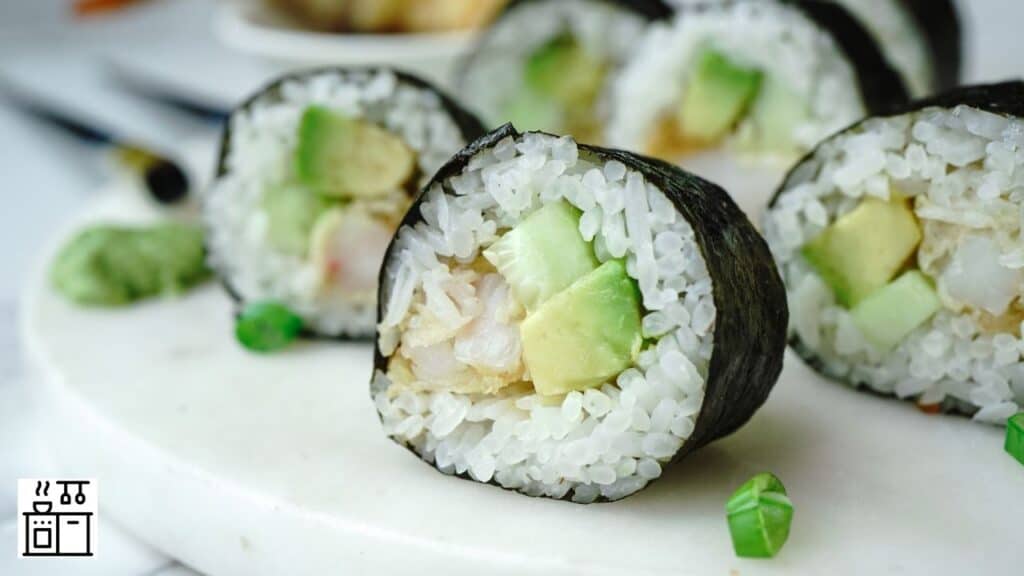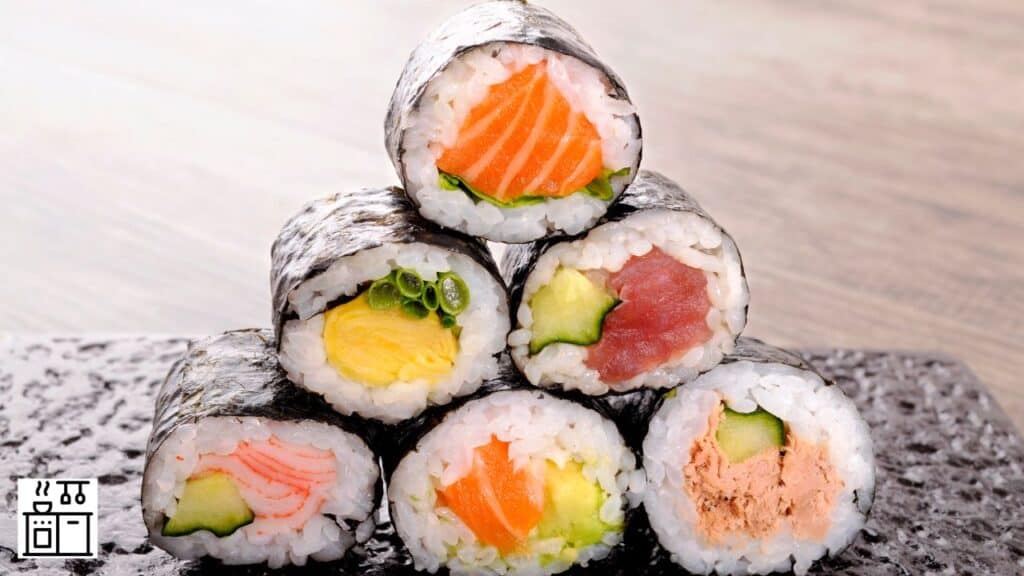Sushi rice is a type of Japanese white rice that differs from regular white rice. It has a high starch and protein content that makes it stickier than regular rice.
It cooks slightly differently as well.
Though it’s traditionally prepared on the stovetop, you can make rice in a rice cooker as well.
Let’s look at how to make it in a rice cooker.
Factors to Consider When Making Sushi Rice in A Rice Cooker
Though you can make sushi rice in a rice cooker, the outcome will depend on the following factors.
1. Type of Rice
Sushi rice is a short-grain variety. It’s starchy, and hence this rice becomes sticky when cooked.
The sticky nature of sushi rice makes it ideal for sushi.
Now, there are different varieties of sushi rice.
The texture and appearance of the rice after cooking will depend on the variety of rice you choose.
The flavor of each variety differs.
The most common variety used to make sushi is Japonica rice, which is cultivated in Japan and Korea.
The grains of this type of rice are short and round.
They cook well and hence can be conveniently shaped into balls.
You can also use medium-grain sushi rice varieties with high amylopectin levels, though it may not produce the same result.
2. Quantity of Water
The ratio of rice to water is different for a rice cooker compared to the stovetop.
To make sushi in the rice cooker, the typical rice-to-water ratio is 1:1 or 1:1.125.
However, it may vary slightly according to the rice cooker model and type of rice.
We recommend checking the appliance manual for instructions to ensure consistent results.
3. Washing the Rice
Sushi rice is high in starch. This starch makes it sticky when cooked.
Like other types of rice, you must wash the rice before cooking sushi.
The better you wash it, the more starch you will remove.
To achieve the right level of stickiness, wash sushi rice at least two times.
However, you need not wash it several times till the water runs clear, like other varieties of rice.
This rice is meant to be a little sticky, and the grains will not separate entirely.
So, you can make it without washing the grains too many times.
4. Type of Rice Cooker
You can make sushi rice in any rice cooker. However, there are rice cookers with a special sushi rice setting.
Choosing such a rice cooker will make cooking easier.
Modern rice cookers with sushi or sticky rice settings use advanced technology like fuzzy logic to automatically adjust the time and temperature.
This ensures that the cooking is performed to perfection and that the texture of the rice is spot-on.
For a basic rice cooker model, you can enable the setting for white rice to cook sushi rice.
5. Choosing the Right Setting
Rice cookers can either have simple or complex controls.
Choosing the appropriate setting will improve the outcome of the cooking process.
Some rice cookers have a dedicated sushi rice setting.
This makes it easy to automatically set the control to make the perfect sushi rice.
If this is not present, you can choose the regular setting for white rice or brown rice.
However, make sure that it matches the water-to-rice ratio to produce ideal results.
6. Adding Vinegar
In the traditional method of making sushi, a vinegar mixture is added to the rice at the end of the cooking process.
The seasoned vinegar mixture will affect the taste and flavor of the rice.
You can either make this mixture by yourself or buy it pre-prepared.
The important factor to consider is that the sugar granules should be completely dissolved in the vinegar solution for a uniform taste, even if you are using a rice cooker.
Steps to Make Sushi Rice in A Rice Cooker

We discussed the main factors to consider when making sushi rice in a rice cooker.
Let’s now look at the different steps to follow to make the perfect sushi rice in a rice cooker.
1. Measure the Right Quantity of Rice and Water
Accurate measurements will produce better results when you are making sushi rice in a rice cooker.
Hence, we recommend using precise measuring tools for this purpose.
Most rice cookers come with a measuring cup. You can use it to measure the rice.
If you haven’t received a measuring cup with your rice cooker, you can use any other measuring cup or glass.
But an important factor to note is that you should use the same cup to measure the water also. It will help you get accurate measurements.
2. Wash the Sushi Rice at Least Twice
Washing rice serves two purposes. Firstly, it removes all the dirt and dust from the rice surface, making it clean and safe to consume.
Secondly, washing the rice grains eliminates the excess starch content from them.
Rinse the rice at least twice to get rid of excess starch. There will still be just enough starch to make the rice sticky and easy to mold.
But it will prevent the rice from becoming too mushy.
3. Choose the Right Cooking Setting
Depending on the rice cooker model, you will have to choose a suitable cooking setting.
If the rice cooker has a special mode for sushi or sticky rice, this would be the best setting.
However, if it’s not present, you can choose the setting for medium or short-grain rice.
For the most basic models, you can just enable the cooking switch.
The results will be impressive if you get the ratio of rice and water correct.
4. Let the Rice Rest After Cooking
Once the rice finishes cooking, let it rest for at least five minutes.
This will give the grains enough time to absorb the excess moisture.
Most rice cookers will also switch to the “Keep Warm” mode during this time.
After five minutes, open the lid and check on the rice.
5. Fluff the Rice Grains and Transfer Them to The Serving Dish
After opening the lid of the rice cooker, gently turn the rice over with a fork or spatula.
This will help the rice grains fluff up.
Then use a spatula to transfer the rice to a serving bowl. The final step is to season the rice.
6. Season the Rice with The Vinegar Mixture
The unique flavor and taste of sushi rice come from the vinegar mixture used for seasoning.
Seasoned rice vinegar is available commercially, and you can use it directly from the bottle.
The other option is to make your very own seasoning mixture at home.
You can customize the vinegar mixture recipe to your liking.
The simplest recipe is 2 cups vinegar with 1.5 cups of white sugar and a few pinches of salt.
You can even squeeze some lemon juice into the liquid if you prefer.
Stir this mixture over a low flame till it combines perfectly.
Pour the seasoning mixture in small batches over the sushi rice.
Then, use a slicing and lifting motion to mix the vinegar into the rice evenly.
Finally, you can serve the sushi rice directly or wrap it in seaweed to make sushi rolls.

